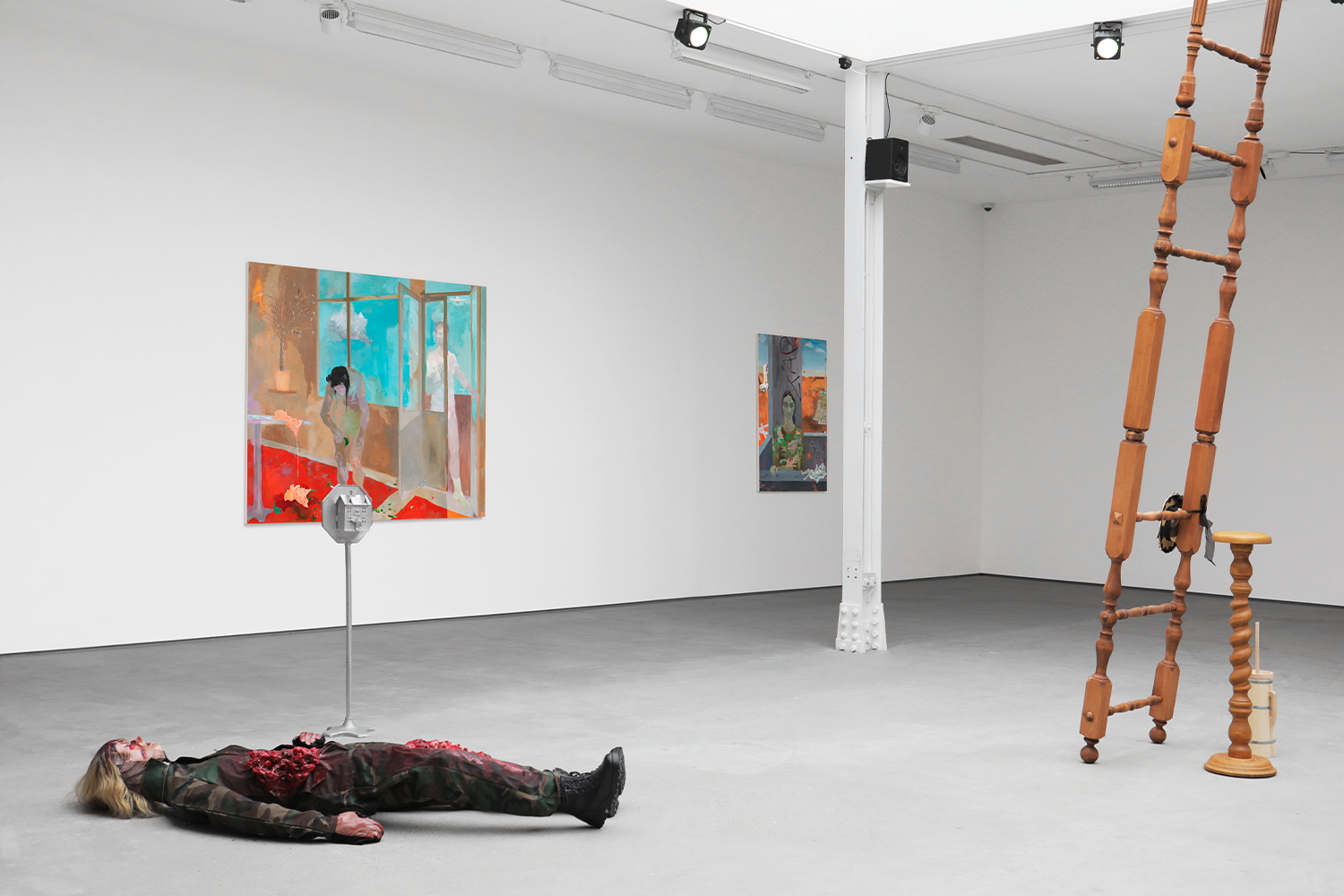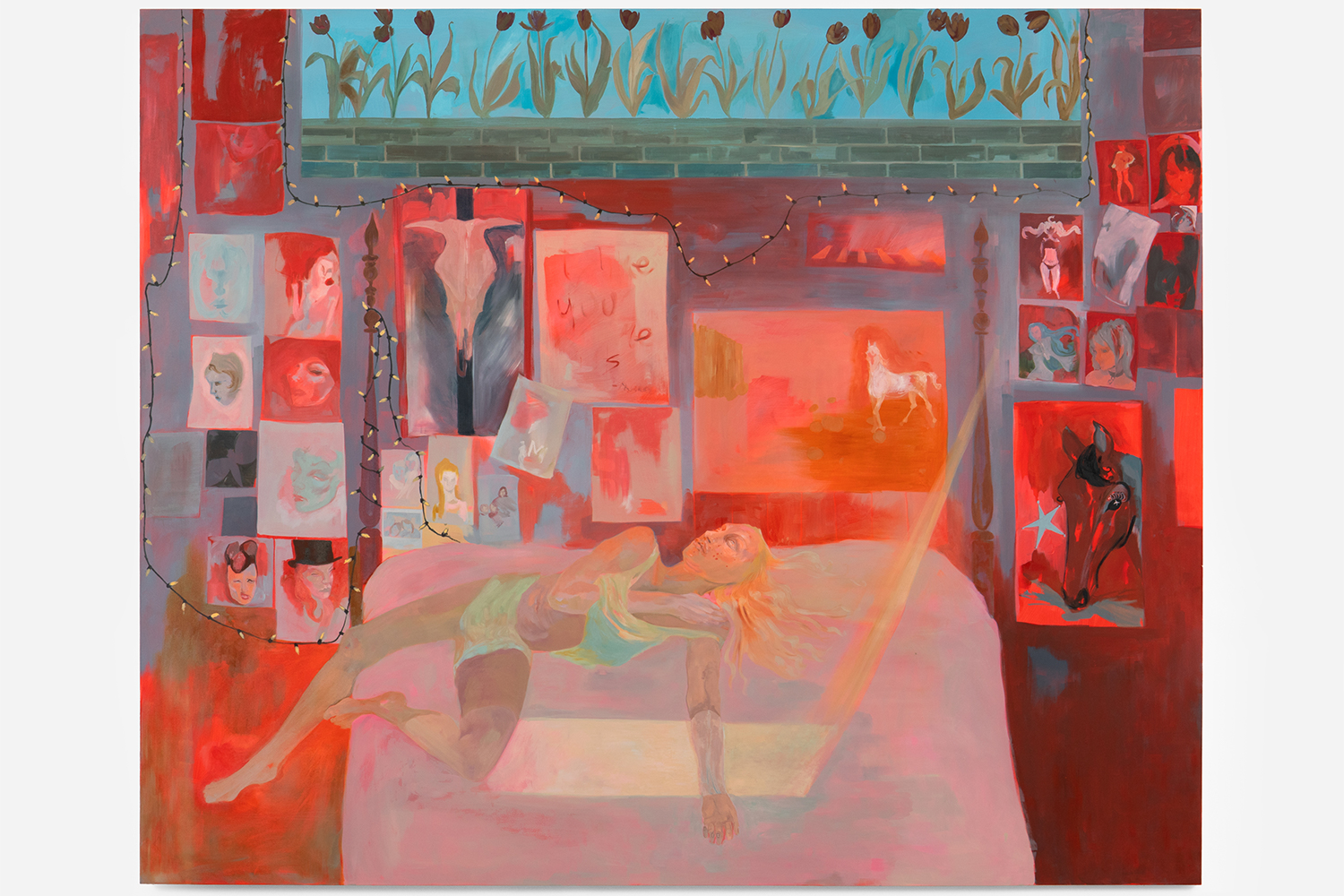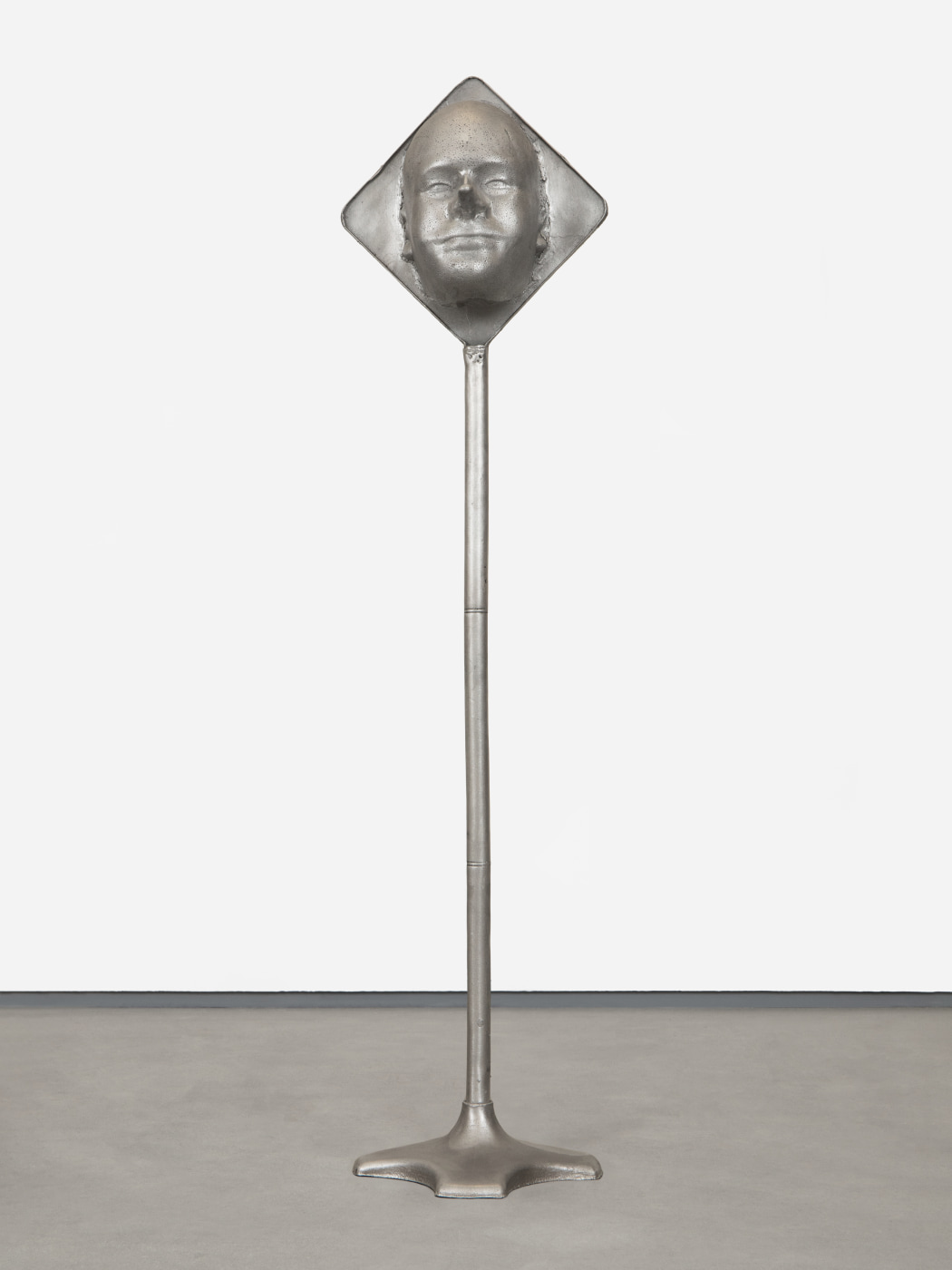Near Death Experience.
Georgia Gardner Gray
Sadie Coles HQ
Exhibition Review
Written October 2022.

Near Death Experience. Installation view. © Georgia Gardner Gray & Sadie Coles HQ.
From brooding memento mori to uncanny tomb effigies, the use of visual art to explore the value of life, by way of death, is perhaps as old as art itself. With that in mind, it is perhaps fitting that Georgia Gardner Gray’s debut British exhibition, Near Death Experience, at Sadie Coles, explores the everyday incidents, labours and archetypes that constitute life now— what it means to exist as pawns and products of our desires, religions, environments, dreams and our human nature, by way of cynicism, commentary and performance. Dreamlike, alone doesn’t do her palette justice; surreal, doesn’t articulate her form with its deserved veneration. These paintings, the likes of which dominate the exhibition walls, teeter between the mundane and the transcendental— transportive and blurry, clearly inspired by the allegorical tradition of Western art tradition along the way, whilst being soaked in an agonising pessimism, as beautiful as it is stubborn. Within her paintings, few figures or faces behold any expressions close to conceivable happiness or contentment, as they labour, lunge and look on dolefully into distant horizons. Their fervent intensities— skin colours exaggerated in impossible tones, with basic scenic details (i.e. locations, time of day etc.) largely omitted, like an unreliable narrator retelling the content of a dream, leaves the bones— the core of these stories, retained, with the flesh— the minutiae, left untold, in an altogether psychedelic haze. To look closely at the faces of her subjects is to see an unsettling, skeletal quality that creeps within each scene; impish, miniature angels and devils sit above subjects' shoulders curiously, as if tempting them into acts beyond their control— in the case of Trinity (2022), seemingly urging one toward the certain danger of a level-crossing. There is unrest, compelling, personal and at many points, with references to worship away from Christianity, exemplified in Sever My Arms, Decorate My Heart (2022), where a store assistant is positioned as if to take on the form of a multi-limbed Hindu deity, as well as the pagan pose of Trinity’s central figure, arms raised as if in a mid-ritual frenzy or divine-incantation, contrasting with the otherwise mundane scene.

Buried Fiber Optic Cable Girlfriend. 2022. © Georgia Gardner Gray & Sadie Coles HQ.
A lap around the room, and it’s clear to see the prevalent colour within each painting to be blue— whether found in skies above arid landscapes, haphazard seas surrounding an ethereal cruise ship, or as a dominant wash across an entire canvas. There is indeed something calming about the artist's use of colour; even in scenes dominated by skeletal self-portraits, or zombie-like stupefied subjects, it injects a subtle optimism of the natural world and in turn, natural order. Nods to the perils of capitalism (exemplified in Sever My Arms, Decorate My Heart), self-destruction (not only the danger of the level-crossing but the Diet Coke and cigarette packet in Trinity) and narcissism (in both Self Portrait In Antiquity and to an extent, Buried Fibre Optic Cable Girlfriend) can’t be ignored either, with Gray subtly analysing a world, seemingly built on dissatisfaction, in which normalised everyday and basic behaviours, rituals and vices do nothing but hypnotise, alienate and pacify— perhaps themselves serving as near-death experiences in that they too raise a pulse, by pulling subjects towards an empty, echoing void. Aside from her paintings, Gray’s Harbinger series, a collection of aluminium cast faces, circles the inner space of the gallery. At just over one metre tall, and with objects curiously mounted on their backs and fronts— buildings, people and other miscellanea, they appear as if manifestations of subconsciouses or echoes of memories; omens perhaps, of desires met, out of reach, or longed for. What is clear, however, is that they, much like her paintings, were created with a death-like intensity— a grave stillness, not unlike funerary masks, as if carefully moulded with the sullen expressions of the dearly departed for centuries to come.
Ultimately, the standout contribution to the exhibition is the eponymously titled performative accompaniment, NDE (displayed by the entrance on an interconnected series of screens) and unfortunately so. At forty-five minutes long, and comprised of a carefully choreographed piece between a cast of enthusiastic performers and a large range of props, it, for the most part, erred too much on the far-fetched, absurdity and pretence, to make it a worthwhile, or worthy addendum to an otherwise consistent, accessible display of works, lost in its introspective desire to communicate as many ideas as possible at the same time, with little direction or coherence. Much like the exhibition’s press release, it feels at times as if NDE required a hired guide to help decipher exactly what it was that was being presented— exercise treadmills, portable stairwells, ladders and a grizzled, army-fatigue-clad bloody mannequin, all being used within a series of tableaus, indistinguishable from the last. At close to an hour of viewing, there is no doubt that the performance brings something to the exhibition, but the question, ultimately, is what, and why?

Harbinger 3. 2022. © Georgia Gardner Gray & Sadie Coles HQ.
Still, where Near Death Experience succeeds, is in placing a magnifying glass over the age in which we currently exist, examining its anthropological, social and psychoanalytical lineages and futures— visitors of all walks of life, ages and backgrounds will be able to relate with it, marvel at it, and stand on in as shock, as awe (and perhaps even wry laughter) on some level at least. In an age, so burdened by religion, technology, isolation, capitalism, and inequality, the presence of cynicism and pessimism, especially as unapologetic as the artist is with it, is not only healthy but necessary with such an artistic reflection, and in pulling no punches, offers a space in which the starkness and darkness of modern living can be seen for its strange beauty and stranger still, allure.